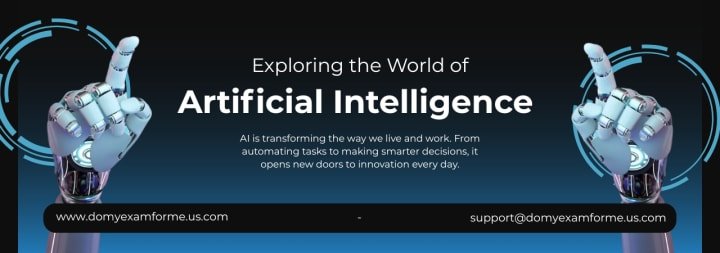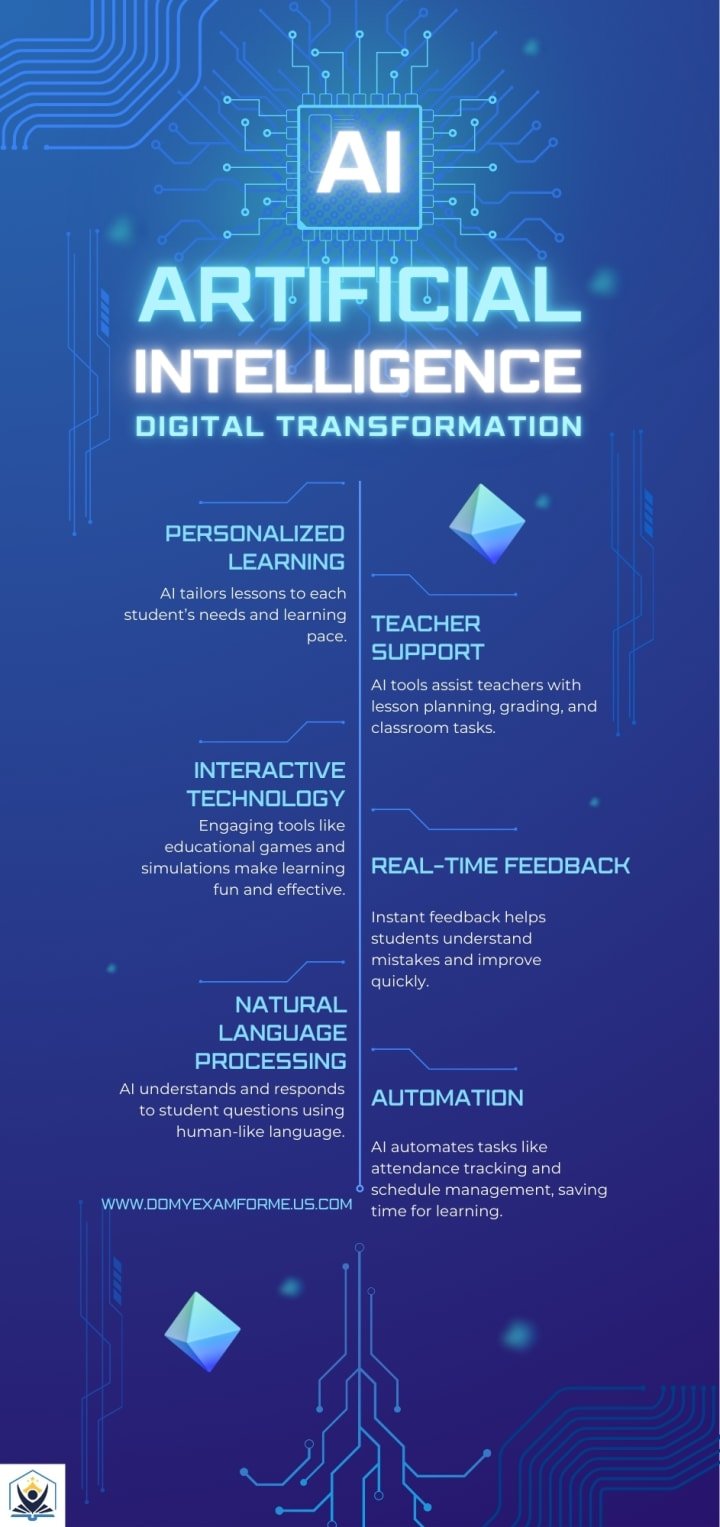Everest Nevraumont, a 10-year-old student at Alpha School Austin, scrolled through a lesson on a laptop Tuesday morning while U.S. Education Secretary Linda McMahon gazed over her shoulder. Nevraumont explained how she can go through the lessons, created by artificial intelligence, largely at her own pace.
Education
Smart Classrooms: The Rise of AI in K-12 Learning

Introduction
Imagine walking into your classroom, and instead of just a teacher and a whiteboard, you see smart screens, talking apps, and AI systems that actually know how you learn best. Sounds like something out of a sci-fi movie, right? But it’s real—and it’s happening right now in schools across the United States.
Smart classrooms powered by artificial intelligence (AI) are quickly becoming the new normal. They’re helping students learn in ways that are faster, more fun, and more personal. This blog dives deep into what smart classrooms are, how they work, the cool things they can do, the issues we need to think about, and where things are headed in the future.
Let’s take a journey into the classroom of tomorrow—and how it’s already changing the way young minds learn today.
What Are Smart Classrooms and Why Are They Gaining Momentum?
A smart classroom isn’t just about having a few tablets or computers in the room. It’s about combining technology and intelligence to make learning more interactive and customized. Smart classrooms use tools like AI software, smartboards, voice recognition, and learning apps to help students understand things better and faster.
These classrooms are gaining momentum because students today grow up with technology. They’re used to smartphones, video games, and voice assistants like Siri or Alexa. So, using technology to learn feels natural. Plus, schools want to help every student succeed—and AI makes it easier to give each person what they need.
The Evolution of Traditional Classrooms
From Chalkboards to Chatbots: A Quick Look Back
Not too long ago, classrooms were filled with wooden desks, chalkboards, and paper textbooks. Teachers would write everything on the board, and students copied notes into notebooks. Fast forward to today—many classrooms now have touchscreen boards, tablets, and software that can grade your tests in seconds!
Chatbots are even helping students find answers to questions when teachers are busy. These changes didn’t happen overnight. Step by step, technology became part of learning. The goal has always been the same: to make learning better, smarter, and more fun.
The Push for Innovation in K-12 Education
Schools are constantly looking for ways to improve. That’s why there’s a big push to use more technology and innovation, especially in grades K through 12. The idea is to help students learn in ways that suit them best. Some students love reading, while others learn better with videos or games. AI can adapt to each student’s needs, making learning more effective for everyone.
Understanding Smart Classrooms
Defining Smart Classrooms in the Age of AI
So, what exactly makes a classroom “smart”? A smart classroom is one where AI and other digital tools are used to personalize learning. It’s a space where technology understands your strengths and helps you work on your weaknesses. It can recommend practice questions, give instant feedback, or suggest new ways to learn a topic.
Think of it as having a personal tutor that’s available 24/7—one that remembers everything you’ve learned and what you struggle with.
Key Technologies Powering Smart Classrooms Today
Behind the scenes, smart classrooms run on some pretty amazing tech:
- Artificial Intelligence (AI): Helps personalize your lessons.
- Machine Learning: Learns from your answers to improve future quizzes.
- Smartboards: Interactive whiteboards you can write on, touch, or use for video lessons.
- Voice Assistants: Can answer questions, set reminders, or read things aloud.
- Augmented Reality (AR): Makes learning more visual—like turning a science lesson into a 3D adventure!
These tools work together to make learning exciting and customized.
The Role of AI in Modern Educational Tools
AI is like the brain behind the scenes. It helps teachers manage assignments, grades, and even class participation. It can spot when a student is struggling and suggest different ways to help. Instead of giving everyone the same lesson, AI tools can offer unique experiences based on how each student learns best.
AI doesn’t replace teachers—it helps them do their jobs even better.
Benefits of Smart Classrooms in K-12 Learning
Personalized Learning Experiences for Every Student
Everyone learns at their own pace. Some kids pick things up quickly; others need more time. Smart classrooms make sure nobody gets left behind. If you’re great at math but struggle with writing, AI can give you extra help in writing while challenging you more in math.
This way, learning isn’t one-size-fits-all. It’s just right for you.
Real-Time Feedback That Helps Students Grow Faster
Waiting a week for a test grade can feel like forever. With smart classrooms, you get feedback instantly. Whether it’s a quiz, writing assignment, or math problem, AI tools can tell you right away what you did well and what you need to work on.
That means you can fix mistakes faster and improve quicker.
How AI Supports Teachers, Not Replaces Them
Teachers are still the heart of the classroom. AI just helps take care of the boring stuff—like grading papers or tracking attendance—so teachers can focus more on helping students.
AI also gives teachers better insights. It can show which topics the whole class struggles with, so they can spend more time explaining those areas.
Increased Student Engagement Through Interactive Tech
Let’s be honest—learning from a textbook can sometimes be boring. Smart classrooms make learning interactive. You might play educational games, take part in live polls, or even explore a science lab in virtual reality.
It’s hard to be bored when the lesson feels like a game or adventure.
Reducing Administrative Burden with Automation
Teachers and school staff spend a lot of time filling out forms, making schedules, and planning lessons. Smart classrooms can automate many of those tasks. That means teachers can spend more time teaching and connecting with students.
Boosting Learning Outcomes with Data-Driven Insights
Every time you take a quiz or complete an assignment, AI tools collect data. Don’t worry—it’s not spying on you! It’s used to understand what’s working and what’s not. Teachers can use that data to make better lesson plans and help every student do their best.

Challenges and Concerns of AI in K-12 Education
Data Privacy and Security in AI-Driven Classrooms
Smart classrooms collect a lot of information. That’s why it’s super important to keep that data safe. Schools and tech companies need strong rules to protect your privacy, so your information doesn’t end up where it shouldn’t.
The Digital Divide: Unequal Access to Smart Technology
Not all schools have the same resources. Some have high-tech classrooms, while others still use old computers. This creates a gap between students who have access to smart tech and those who don’t. Closing this digital divide is one of the biggest challenges.
Over-Reliance on AI: Are We Losing the Human Touch?
AI is smart—but it doesn’t have feelings. Teachers can understand emotions, build relationships, and inspire students in ways machines can’t. If we rely too much on AI, we risk losing that important human connection.
Teacher Training and Resistance to New Tech
Not all teachers are comfortable using new technology. Some feel overwhelmed or worry they won’t do it right. That’s why schools need to provide training and support. Everyone—teachers included—should feel confident in a smart classroom.
Cost Barriers and Funding Issues for Public Schools
Smart technology can be expensive. Public schools, especially in low-income areas, may not have the money to buy the newest gadgets. To make smart classrooms fair for all, governments and communities need to invest in schools equally.
Impact on Students and Teachers
How Smart Classrooms Are Changing the Student Mindset
When students see learning as something fun and interactive, they become more curious and confident. They’re more likely to ask questions, try new things, and take charge of their own learning. Smart classrooms help build that positive mindset.
Teacher Perspectives: Stress or Support?
Some teachers feel stressed by all the new technology. But many are also excited by the possibilities. When used right, smart tools can make teaching easier and more creative. It’s all about balance and proper training.
Adapting Teaching Methods to AI Integration
Teaching isn’t just about standing in front of the class and talking anymore. With smart classrooms, teachers use videos, quizzes, games, and group projects. They also use AI tools to check progress and adjust lessons. It’s a new way of teaching—and learning.
Case Studies and Real-World Examples
Successful Implementation of AI in K-12 Schools
Schools in California and New York are already using AI-powered tools to help students learn languages, improve math scores, and even get emotional support through AI chatbots. These success stories show what’s possible when technology and teaching come together.
Lessons Learned from Early Adopters
The schools that started using AI early have learned a lot. They’ve seen how important it is to include teachers, students, and parents in the process. They’ve also learned that tech works best when it’s used to support not replace traditional teaching.
The Future of Smart Classrooms
Emerging AI Trends in Education to Watch
Here’s what’s coming next:
- AI tutors that talk like real people
- Learning programs that adjust every day to your progress
- Virtual classrooms where students from around the world learn together
The future is not just exciting—it’s already on its way.
What Classrooms Might Look Like in the Next 10 Years
In ten years, classrooms may look like science labs or gaming studios. Students might use AR glasses, learn from AI mentors, and create projects in 3D environments. School will be more flexible, creative, and connected to real-world skills.
How Policymakers Are Shaping the Future of AI in Schools
Lawmakers and education leaders are now writing the rules for AI in schools. They’re making sure it’s used safely, fairly, and effectively. This means setting limits, protecting privacy, and making sure all students benefit equally.
Ethical Considerations and Safeguards
Balancing Innovation with Responsibility
Just because we can use AI doesn’t mean we always should. Schools need to think carefully about when and how to use smart tools. The goal is to help—not to control.
Creating Ethical Guidelines for AI in Classrooms
Experts are working on ethical rules for AI in schools. These include protecting student privacy, preventing bias, and making sure AI is used to support—not harm—young learners.
Parental and Community Involvement
Helping Parents Understand Smart Classroom Technology
Parents need to know what’s happening in their child’s classroom. Schools should offer workshops, videos, or newsletters to explain how smart technology works—and how it helps students succeed.
Building Trust and Transparency Around AI in Schools
The more people understand AI, the more they trust it. Schools should be open about how they use AI and what data they collect. That builds confidence and community support.
Conclusion
Smart classrooms are changing the way we learn—and for the better. They make lessons more exciting, help students grow faster, and give teachers the tools to do amazing things. But it’s also important to be careful and thoughtful. We must make sure all students have access to these tools, that teachers get support, and that families stay informed.
And remember, no piece of technology can replace hard work, curiosity, and a love for learning. AI can guide you, support you, and even say, “Do my Exam For Me,” but real success still comes from within.
The classroom of tomorrow is already here. The question is—are we ready for it?
Education
Corporate Giants Commit To Support AI Education Across US
The White House has announced that a number of major organizations have committed to provide resources for imparting AI education to America’s youth.
Michael Kratsios, Director of the White House Office of Science and Technology Policy and Chair of the White House Task Force on AI Education, said leaders in business, non-profits, and education have pledged to provide free AI training and resources to students, teachers, and parents across the country.
Google committed $1 billion to support education and job training programs in the U.S. Google said that they will offer every American high school and their students, teachers and staff access to Gemini for Education for free. This includes Gemini 2.5 Pro, plus tools like Guided Learning and Notebook LM.
For college students, Google’s AI for Education Accelerator has expanded from one hundred colleges and universities to two hundred. The search engine giant also committed $150 million in grants over the next three years to support AI Education and Digital Wellbeing. This includes $3 million to code.org and $2 million to the Flourish Fund, a centralized website Google created for teachers and parents to provide best AI training in one place.
Code.org promised to “Engage 25 million learners in an Hour of AI in school year ’25/’26”. It will partner with 25 states during the next three years to build and promote AI pathways, AI Standards, and the AI Education Act.
Code.org will develop and scale a new free, open-source high school course – AI Foundations – focused on AI, reaching 400,000 US high school students annually by school year ’28/’29. It will also provide free, open-source AI+CS learning for 9M US K-8 students annually by school year ’28/’29”.
IBM said it will skill 2 million learners by 2028 through its Skillsbuild program and other courses that prepare the current and future American workforce with necessary AI and related technology skills.
Zoom has committed $5 million over three years in support of K-12 education through a series of multi-year grants. This initiative aims to empower the next generation of learners, educators, and workers by equipping them with critical skills for an AI-driven future.
NVIDIA has announced a commitment valued at $25 million over the next 5 years dedicated to developing K-12 AI skills and training.
Mastercard said that it will enhance and expand the Kids4Tech AI curriculum with new, ready-to-use classroom resources over the next five years.
Microsoft said it will provide to every K12 student in the United States free access for the academic year to its AI CoPilot, which is built on Microsoft technology and OpenAI’s most current AI models. “We’ll work with every school both to make this technology available and to support teacher training, including by funding $1.25 million in prizes for the Presidential AI Challenge to recognize top educators in every state”.
Amazon said that by 2028 it will support AI skills training for four million U.S. learners, enable AI curricula for 10,000 U.S. educators, and provide up to $30 million in credits for eligible organizations to use cloud and AI technology to support students and educators in the U.S.
Apple said it will expand its free learning content with new resources to help students, teachers, and developers learn and use generative AI and machine learning. Apple is developing new curriculum and training programs with Common Sense Media to help educators teach responsible AI.
Adobe said that through Adobe Express for Education, its all-in-one creativity app, every K-12 student in the U.S. will be able to create, explore and grow using generative AI tools designed for the classroom.
Meta has committed more than $20 million to provide educators and students with AI resources.
For comments and feedback contact: editorial@rttnews.com
Education
Victorian government partners with Cturtle to boost international alumni careers

TalentConnect is a Victorian government platform connecting skilled migrants and international professionals in cyber and digital technology with employers across Victoria, Australia.
The TalentConnect website is built by Cturtle using its proprietary TalentMatch technology on behalf of the Victorian government’s skilled and business migration program.
With a global talent shortage, and an estimated 84 million candidate shortfall by 2030, Cturtle’s mission is to helps companies, governments, and universities track and engage global talent and alumni by using big data and AI-driven insights.
While its TalentMatch feature connects international graduates, alumni and high demand global talent with jobs, Cturtle is also being used by universities across Australia, the UK and the US in a number of different ways.
There are ways that universities can use the data that we have to help their rankings. That’s always a huge focus of the universities
Shane Dillon, Cturtle
“There are ways that universities can use the data that we have to help their rankings. That’s always a huge focus of the universities,” Shane Dillon, founder of Cturtle, told The PIE.
Cturtle equips universities with verified graduate data including employment rates, salaries, industries, and job locations, aligned with global ranking metrics. This helps institutions showcase impact by program, degree level, and graduate demographic.
According to Dillon, universities are also using the platform to track and reconnect with alumni. “We’re tracking their employment data, we tend to also have up-to-date contact information, so the universities can use that,” said Dillon.
Cturtle identifies and tracks alumni – even those not active in alumni networks – providing universities with a clearer picture of graduate outcomes and mobility.
Having these data insights, through a database of 2.5 million international alumni employment and salary outcomes, can also be useful in demonstrating the return on investment to the prospective students, the Cturtle founder told The PIE.
With growing calls from students for greater transparency, Cturtle provides data on graduate outcomes — including salaries, industries, and employers — for individual academic programs. The aim is to support recruitment, strengthen trust, and help institutions stand out in an increasingly competitive global education market.
Education
Education Secretary McMahon visits Austin private school using AI mode
U.S. Education Secretary Linda McMahon meets Alpha School students Milam Morgan, 7, left, his brother Rivers Morgan, 5, and their parents Searcy and Brooks Morgan, during a tour of the Alpha School to highlight the importance of national AI literacy in Austin, Tuesday, Sept. 9, 2025.
Jay Janner/Austin American-Statesman“In reading, I’m grade nine, but in math I’m only grade five,” Nevraumont said. “In reading, I’ve advanced way faster.”
Article continues below this ad
U.S. Education Secretary Linda McMahon meets Alpha School students Rivers Morgan, 5, his brother, Milam, 7, left, and their parents Searcy and Brooks Morgan, during a tour of the Alpha School in Austin on Tuesday to highlight the importance of AI literacy.
Looking on, McMahon said the model was “the most exciting thing (she’s) seen in the education world in a long time.”
McMahon visited Alpha School, a private school in the Barton Hills area of Southwest Austin, to learn about its “2-hour learning” model, which uses AI-developed curriculum to teach core instruction.
The Austin visit was another stop on McMahon’s “Returning Education to the States” tour, in which she has so far visited roughly a dozen schools, following a March executive order from President Donald Trump to dismantle the Education Department.
Article continues below this ad
During the visit, McMahon praised the Alpha School’s use of AI as an opportunity for other schools to develop new tools for teachers.
“Let’s be motivated in our states and in our school systems to inspire them to be curious enough to come and understand what is happening here,” McMahon said.
U.S. Education Secretary Linda McMahon, left, and Alpha School co-founder MacKenzie Price, participate in a round table discussion at the Alpha School to highlight the importance of national AI literacy in Austin, Tuesday, Sept. 9, 2025.
Jay Janner/Austin American-StatesmanAlpha School, founded in 2014, has locations in Arizona, California, Florida and New York. A Houston location is set to open this winter.
Article continues below this ad
Students learn through AI-driven curriculum for two hours a day with assistance from adult staff members known as guides, rather than teachers. They spend the remaining hours of the school day developing practical skills in finance, entrepreneurship and public speaking through workshops or group projects.
This approach keeps students engaged and uses personalized instruction, said MacKenzie Price, co-founder of the national school.
“It’s time for us to all hold ourselves responsible for delivering better for these kids. I think that using artificial intelligence is what enables us to raise human intelligence, not just for the students but also for the teachers,” Price said.
Texas Education Commissioner Mike Morath, who also visited the school Tuesday, said AI use can be a tool when designed with sensitivity.
Article continues below this ad
Texas Education Agency Commissioner Mike Morath listens during a round table discussion with U.S. Education Secretary Linda McMahon at the Alpha School to highlight the importance of national AI literacy in Austin, Tuesday, Sept. 9, 2025.
Jay Janner/Austin American-Statesman“You have to know how the technology can be used, and used effectively, because if you don’t use it in the right way, it can either become districting or ultimately become harmful,” Morath said. “It just depends on how it is deployed.”
McMahon is the second education secretary to visit an Austin campus in just two years.
In March 2023, Miguel Cardona, who was education secretary under President Joe Biden, toured Webb Middle School in North Austin to promote bilingual education.
Article continues below this ad
McMahon’s visit comes as significant change is underway at the federal department.
A budget proposal released last week would reduce education spending by $12 billion, about 15%, in the 2026 fiscal year. The cuts would include reductions to Title I money, which helps fund school serving low-income students, but would increase funding for special education and charter schools.
U.S. Education Secretary Linda McMahon chats with Alpha School student Everest Nevraumont, 10, and school co-founder MacKenzie Price after a round table discussion to highlight the importance of national AI literacy in Austin, Tuesday, Sept. 9, 2025.
Jay Janner/Austin American-StatesmanMcMahon said part of the intention of her tour across the county is to understand the most effective education practices in each state.
Article continues below this ad
“That’s a big part of what we can do to help different schools in different areas to understand what might be available,” McMahon said.
Texas has leaned into additional options for technology in school in recent years.
In 2021, lawmakers passed legislation to increase options for virtual learning. In 2023, the State of Texas Assessments of Academic Readiness moved all-digital, rather than a paper and pencil test.
Article continues below this ad
-

 Business2 weeks ago
Business2 weeks agoThe Guardian view on Trump and the Fed: independence is no substitute for accountability | Editorial
-
Tools & Platforms4 weeks ago
Building Trust in Military AI Starts with Opening the Black Box – War on the Rocks
-

 Ethics & Policy1 month ago
Ethics & Policy1 month agoSDAIA Supports Saudi Arabia’s Leadership in Shaping Global AI Ethics, Policy, and Research – وكالة الأنباء السعودية
-

 Events & Conferences4 months ago
Events & Conferences4 months agoJourney to 1000 models: Scaling Instagram’s recommendation system
-

 Jobs & Careers2 months ago
Jobs & Careers2 months agoMumbai-based Perplexity Alternative Has 60k+ Users Without Funding
-

 Podcasts & Talks2 months ago
Podcasts & Talks2 months agoHappy 4th of July! 🎆 Made with Veo 3 in Gemini
-

 Education2 months ago
Education2 months agoMacron says UK and France have duty to tackle illegal migration ‘with humanity, solidarity and firmness’ – UK politics live | Politics
-

 Education2 months ago
Education2 months agoVEX Robotics launches AI-powered classroom robotics system
-

 Funding & Business2 months ago
Funding & Business2 months agoKayak and Expedia race to build AI travel agents that turn social posts into itineraries
-

 Podcasts & Talks2 months ago
Podcasts & Talks2 months agoOpenAI 🤝 @teamganassi





















